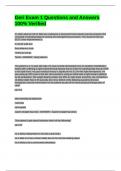Exam (elaborations)
Geri Exam 1 Questions and Answers 100% Verified
- Course
- Institution
Geri Exam 1 Questions and Answers 100% VerifiedGeri Exam 1 Questions and Answers 100% VerifiedGeri Exam 1 Questions and Answers 100% VerifiedGeri Exam 1 Questions and Answers 100% VerifiedGeri Exam 1 Questions and Answers 100% VerifiedGeri Exam 1 Questions and Answers 100% VerifiedAn older adult at...
[Show more]



